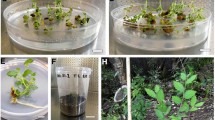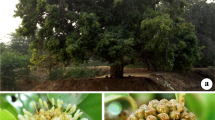Abstract
Tigridiopalma magnifica is a rare and endemic perennial herb plant, the only species in the genus Tigridiopalma in in the Melastomatacea family in Yangchun, Xinyi, and Gaozhou cities of China, where it is categorized as Critically Endangered on the national Red List. Twelve locations with less 10,000 individuals of T. magnifica have been identified (1 extinct, 11 extants). T. magnifica only grows in the surface soil on stone walls or rocks under the canopy of secondary forests and plantations and has no specific associated plant species. An efficient propagation in vitro system using seeds and leaves as explants has been established for T. magnifica C. Chen. About 20,000 well-developed root systems were transferred to planting pots containing a mixture of sand, sieved peat, and perlite (1:1:1; v/v) in greenhouse conditions. More than 80.0% of the plantlets survived after 30 days. We reintroduced 10,000 plantlets produced by tissue culture into three reintroduction locations in and outside the current and historical distribution area of this species. After 11 months survival rate was 40–58%, while the survival was higher and plantlet crowns were larger at the location within the original range of the species than at the other two sites.
Access provided by Autonomous University of Puebla. Download chapter PDF
Similar content being viewed by others
Keywords
1 Introduction
Tigridiopalma magnifica C. Chen is a rare and endemic perennial herb plant in the Melastomatacea family in Yangchun, Xinyi, and Gaozhou cities of China (Fig. 1), where it is categorized as Critically Endangered on the national Red List (Chen 1979; Zhang and Miao 1984). This herb also has the potential as an ornamental plant because it is tolerant of shade and has charming leaves with reddish villi and beautiful flowers (Zeng 2005). Because of habitat destruction, human disturbances, and climate change, the population size of T. magnifica has drastically decreased during the past century. Twelve locations with populations of T. magnifica have been identified (1 extinct, 11 extants). T. magnifica only grows in the surface soil on stone walls or rocks under the canopy of forests and plantations and has no specific associated plant species. Canopy closure, soil water content, and the distance to the closest stream are the main factors influencing the distribution of T. magnifica (Fig. 2). It was estimated that there were less than 10,000 individuals of this endangered plant in the wild (Ren et al. 2012).
2 Description of Reintroduction
2.1 Feasibility
We studied the distribution (Fig. 3), conservation status, ecological and biological characteristics, reproductive biology, tissue culture (Zeng et al. 2008), and horticulture of T. magnifica since 2003 (Zeng 2005; Ren et al. 2012). An efficient propagation in vitro system using seeds and leaves as explants has been established for T. magnifica C. Chen, and about 20,000 well-developed root systems were transferred to planting pots containing a mixture of sand, sieved peat, and perlite (1:1:1; v/v) in greenhouse conditions. Over 80.0% of the plantlets survived after 30 days, and the regenerated plantlets could flower after 2-year transplanting (Fig. 4). We established three reintroduction sites at Dajiangkou Village (111°30′ E, 21°55′ N) in Yangchun city, Ehuangzhang Village (111°46′ E, 22°20′ N) in Yangchun city, and Tianxin Forestry Farm (112°21′ E, 25°6′ N) in Lianzhou city, Guangdong, Southern China in 2008 (Fig. 5) with the regenerated plantlets transplanted for 1 or 2 years. The first location is an augmentation reintroduction within an extant population. The second location is a reintroduction site within the historical range of T. magnifica but had no population at present. The third location, Tianxing Forestry Farm, is an introduction site outside the historical range of the species. The structure of the plant community at the third site is similar to that at Ehuangzhang Village (Ren et al. 2012).
2.2 Implementation
We obtained about 20,000 plantlets by propagation in vitro and acclimatized these plantlets at the South China Botanical Garden in 2007. Among them, 10,000 plantlets were used in reintroduction. During the reintroduction acclimation period, the plantlets were watered during the first 3 days after transplantation but not thereafter. The quadrats were not fenced, fertilized, or mulched. In addition, we proposed successfully to the local government to establish a small natural reserve to conserve the remaining wild and reintroduced individuals of this endangered plant in 2010. Thirty-four months after transplantation, the survival rate was 45%, 33%, and 33% at Dajiangkou, Ehuangzhang, and Tianxin, respectively. We also successfully established an ex situ collection in the experimental area of the Tianxin nature reserve, Lianzhou city, in 2010 (Ren et al. 2012).
2.3 Post-planting Monitoring
After transplanting, we observed and monitored the survival, height, and crown of all transplants from 2010 to 2017. The monitoring was carried out once per 3 months during the first year and once per year thereafter. About 60% of the transplanted plantlets survived by 2016, and possible causes of some transplants’ mortality were defoliation by the larvae of a noctuid moth, strong radiation, and lack of water. We found that transplanted plantlets grew slower than wild T. magnifica. Although all the surviving individuals had flowered and produced seeds by 34 months at the locations where they were reintroduced, the germination rate in the field was low because seed germination needs illumination, while the seeds are tiny and are easy to be washed into the soil without illumination. However, we also found more than 500 next-generation individuals in 2017 (Fig. 6).
3 Problems and Recommendations
-
It is essential to have an integrated plan for species recovery of T. magnifica, which includes thorough investigation of germplasm resources, in situ and ex situ conservation, establishment of efficient propagation systems, and prevention of plant removal.
-
There may be some remaining populations at other locations in this area, which need further investigating. The genetic diversity of all surviving T. magnifica populations should be analyzed by molecular tools as a support to the protection to all germplasm resources with different genetic diversities.
-
An efficient propagation system is necessary to produce lots of plantlets for commercial use, which can reduce the demand for wild resources.
-
The best method for conservation of rare and endangered plant is in situ preservation, Reintroduction can be used as a helpful tool to conserve biodiversity, but it is difficult and expensive. However, the local farmers unintentionally disturbed or sometimes destroyed the reintroduction sites, which can only be resolved by legislation, public education, and suitable economic compensation.
References
J. Chen, A new genus Tigridiopalma C. Chen of Melastomataceae. Acta Bot. Yun. 1, 106–109 (1979)
H. Ren, S.J. Zeng, L.N. Li, et al., Community ecology and reintroduction of Tigridiopalma magnifica, a rare and endangered herb. Oryx 46(3), 371–398 (2012)
S.J. Zeng, Rare foliage plants—Tigridiopalma magnifica. Flower Pot Garden. 12, 39 (2005)
S.J. Zeng, J. Duan, L.N. Li, et al., Plant regeneration from leaf explants of Tigridiopalma magnifica (Melastomataceae). Pak. J. Bot. 40, 1179–1184 (2008)
H.D. Zhang, Y.H. Miao, Flora of China (Science Press, Beijing, 1984)
Author information
Authors and Affiliations
Corresponding author
Editor information
Editors and Affiliations
Rights and permissions
Copyright information
© 2020 The Editor(s) (if applicable) and The Author(s), under exclusive license to Springer Nature Singapore Pte Ltd.
About this chapter
Cite this chapter
Zeng, S., Ren, H., Li, L., Wu, K. (2020). Reintroduction of Tigridiopalma magnifica C. Chen, a Critically Endangered Endemic Plant in China. In: Ren, H. (eds) Conservation and Reintroduction of Rare and Endangered Plants in China. Springer, Singapore. https://doi.org/10.1007/978-981-15-5301-1_7
Download citation
DOI: https://doi.org/10.1007/978-981-15-5301-1_7
Published:
Publisher Name: Springer, Singapore
Print ISBN: 978-981-15-5300-4
Online ISBN: 978-981-15-5301-1
eBook Packages: Biomedical and Life SciencesBiomedical and Life Sciences (R0)










